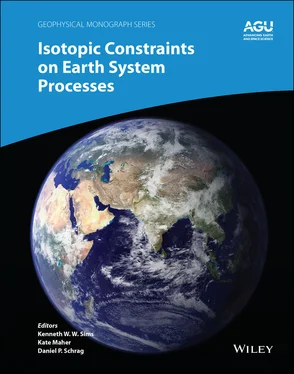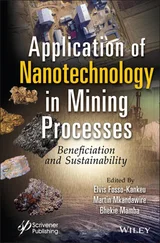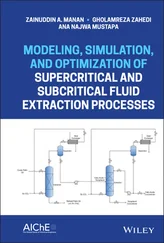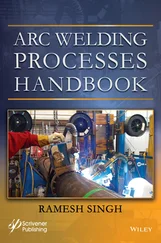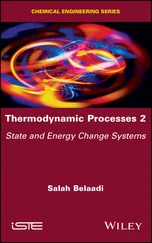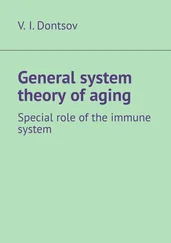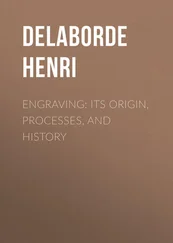Isotopic Constraints on Earth System Processes
Здесь есть возможность читать онлайн «Isotopic Constraints on Earth System Processes» — ознакомительный отрывок электронной книги совершенно бесплатно, а после прочтения отрывка купить полную версию. В некоторых случаях можно слушать аудио, скачать через торрент в формате fb2 и присутствует краткое содержание. Жанр: unrecognised, на английском языке. Описание произведения, (предисловие) а так же отзывы посетителей доступны на портале библиотеки ЛибКат.
- Название:Isotopic Constraints on Earth System Processes
- Автор:
- Жанр:
- Год:неизвестен
- ISBN:нет данных
- Рейтинг книги:4 / 5. Голосов: 1
-
Избранное:Добавить в избранное
- Отзывы:
-
Ваша оценка:
- 80
- 1
- 2
- 3
- 4
- 5
Isotopic Constraints on Earth System Processes: краткое содержание, описание и аннотация
Предлагаем к чтению аннотацию, описание, краткое содержание или предисловие (зависит от того, что написал сам автор книги «Isotopic Constraints on Earth System Processes»). Если вы не нашли необходимую информацию о книге — напишите в комментариях, мы постараемся отыскать её.
Volume highlights include: Isotopic Constraints on Earth System Processes
The American Geophysical Union promotes discovery in Earth and space science for the benefit of humanity. Its publications disseminate scientific knowledge and provide resources for researchers, students, and professionals.
Isotopic Constraints on Earth System Processes — читать онлайн ознакомительный отрывок
Ниже представлен текст книги, разбитый по страницам. Система сохранения места последней прочитанной страницы, позволяет с удобством читать онлайн бесплатно книгу «Isotopic Constraints on Earth System Processes», без необходимости каждый раз заново искать на чём Вы остановились. Поставьте закладку, и сможете в любой момент перейти на страницу, на которой закончили чтение.
Интервал:
Закладка:
48 Thomas, J. B., & Watson, E. B. (2014). Diffusion and partitioning of magnesium in quartz grain boundaries. Contributions to Mineralogy and Petrology, 168, 1–12. https://doi.org/10.1007/s00410‐014‐1068‐5
49 Tsuchiyama, A., Kawamura, K., Nakao, T., & Uyeda, C. (1994). Isotopic effects on diffusion in MgO melt simulated by the molecular dynamics (MD) method and implications for isotopic mass fractionation in magmatic systems. Geochimica et Cosmochimica Acta, 58, 3013–3021. https://doi.org/10.1016/0016‐7037(94)90175‐9
50 Tyrell, H. J. V. (1961). Diffusion and Heat in Liquids. Butterworths, London, pp. 329.
51 Watkins, J. M., DePaolo, D. J., Huber, C., & Ryerson, F. J. (2009). Liquid composition‐dependence of calcium isotope fractionation during diffusion in molten silicates. Geochimica et Cosmochimica Acta, 73, 7341–7359. https://doi.org/10.1016/j.gca.2009.09.004
52 Watkins, J. M., DePaolo, D. J., Ryerson, F. J., & Peterson, B. T. (2011). Influence of liquid structure on diffusive isotope separation in molten silicates and aqueous solutions. Geochimica et Cosmochimica Acta, 75, 3103–3118. https://doi.org/10.1016/j.gca.2011.03.002
53 Watkins, J. M., Liang, Y., Richter, F., Ryerson, F. J., & DePaolo, D. J. (2014). Diffusion of multi‐isotopic chemical species in molten silicates. Geochimica et Cosmochimica Acta, 139, 313–326. https://doi.org/10.1016/j.gca.2014.04.039
54 Watkins, J. M., DePaolo, D. J., & Watson, E. B. (2017). Kinetic fractionation of non‐traditional stable isotopes by diffusion and crystal growth reactions. Reviews in Mineralogy and Geochemistry, 82, 85–125. https://doi.org/10.2138/rmg.2017.82.4
55 Watson, E. B., Wark, D. A., Price, J. D., & Van Orman, J. A. (2002). Mapping the thermal structure of solid‐media pressure assemblies. Contributions to Mineralogy and Petrology, 142, 640–652. https://doi.org/10.1007/s00410‐001‐0327‐4
56 Watson, H. C., Richter, F., Liu, A., & Huss, G. R. (2016). Iron and nickel isotope fractionation by diffusion, with applications to iron meteorites. Earth and Planetary Science Letters, 451, 159–167. https://doi.org/10.1016/j.epsl.2016.06.030
57 Wimpenny, J., Marks, N., Knight, K., Rolison, J. M., Borg, L., Eppich, G., et al. (2019). Experimental determination of Zn isotope fractionation during evaporative loss at extreme temperatures. Geochimica et Cosmochimica Acta, 259, 391–411. https://doi.org/10.1016/j.gca.2019.06.016
58 Xiao, Y., Zhang, H.‐F., Deloule, E., Su, B.‐X., Tang, Y.‐J., Sakyi, P., et al. (2015). Large lithium isotopic variations in minerals from peridotite xenoliths from Eastern North China Craton. Journal of Geology, 123, 79–94. https://doi.org/10.1086/680222
2 Ca and K Isotope Fractionation by Diffusion in Molten Silicates: Large Concentration Gradients Are Not Required to Induce Large Diffusive Isotope Effects
James M. Watkins1, John N. Christensen2, Donald J. DePaolo2,3, and Frederick J. Ryerson4
1 Department of Earth Sciences, University of Oregon, Eugene, Oregon, USA
2 Earth and Environmental Science Area, Energy Geosciences Division, Lawrence Berkeley National Laboratory, Berkeley, California, USA
3 Department of Earth and Planetary Science, University of California, Berkeley, California, USA
4 Atmospheric, Earth, and Energy Division, Lawrence Livermore National Laboratory, Livermore, California, USA
ABSTRACT
Laboratory experiments were used to investigate diffusive isotopic fractionation of calcium and potassium in phonolite‐rhyolite diffusion couples. The starting compositions have very different SiO 2and K 2O, but similar CaO. These were juxtaposed and held in a completely molten state at 1450 °C and 1.0 GPa for durations of 2.5 or 6 hours in a piston cylinder apparatus. The resulting major‐element diffusion profiles exhibit many complexities, including uphill diffusion of all major oxide components. The diffusive fluxes for SiO 2, K 2O, and CaO were modeled using a published modified effective binary diffusion model, whereby diffusion is driven by activity gradients that are solely a function of the time‐evolving SiO 2concentration. Both Ca and K exhibit large diffusive isotope effects that can be explained by imposing a mass dependence on the diffusion coefficients used to model the major‐element profiles. The mass dependence is parameterized in terms of the inverse ratio of the isotope masses raised to an empirically determined exponent β (i.e., D i/ D j= [ m j/ m i] β). Our results confirm that β factors vary depending on the element as well as liquid composition, and that large diffusive isotope effects can arise even in the absence of a large initial concentration gradient. The retrieved β factor for Ca (0.10 ± 0.02) is typical of Ca in natural silicate liquids, whereas the β factor for K (0.25 ± 0.03) is the highest value yet reported, suggesting that large diffusive K isotope effects may yet be found in high‐ T environments.
2.1. INTRODUCTION
Igneous and metamorphic rocks exhibit stable isotope variations in excess of what can reasonably be attributed to mixing processes or equilibrium partitioning during partial melting and (re)crystallization. Experimental studies have shown that diffusion is capable of generating measurable (sub‐permil) to large (tens of permil) kinetic isotopic fractionations that can account for some of this variability, and detailed knowledge of these effects can yield unique insights into the molecular level controls on diffusive transport and the role of kinetics in the formation of minerals in high temperature settings (Antonelli et al., 2019b; Barrat et al., 2005; Beck et al., 2006; Chen et al., 2018; Chopra et al., 2012; Dauphas, 2007; Dauphas et al., 2010; Gallagher & Elliott, 2009; Gao et al., 2011; Jeffcoate et al., 2007; Kil et al., 2016; Lundstrom et al., 2005; Marschall et al., 2007; Mueller et al., 2014; Oeser et al., 2015; Parkinson et al., 2007; Richter et al., 2009, 2014, 2016, 2017; Roskosz et al., 2006; Rudnick & Ionov, 2007; Sio et al., 2013; Su et al., 2016; Teng et al., 2006, 2011; Wu et al., 2018; Zhao et al., 2017).
Current knowledge of diffusive isotopic fractionations in molten silicates is based on a few elements (Ca, Fe, Mg, Li, and Si) and silicate melt compositions (cf. Watkins et al., 2017, for a review). The mass dependence on diffusion coefficients varies between cations and with liquid composition. In basalt‐rhyolite diffusion couples, for example, the stable isotopes of major elements (Ca, Fe, Mg) exhibit less mass discrimination ( β < 0.075) than the stable isotopes of trace element Li ( β ≈ 0.215) (Richter et al., 2003, 2009; Watkins et al., 2009). In simplified silicate liquids, it has been found that the β factor for Ca and Mg varies between 0.05 and 0.21, depending on liquid composition, and is correlated with the “solvent‐normalized” diffusivity (e.g., D Ca/ D Si), suggesting that faster diffusing elements exhibit greater mass discrimination because they move as single atoms or small moities whose diffusion is decoupled from that of the major melt structures/components (Goel et al., 2012; Watkins et al., 2009, 2011). This simple relationship provides a useful framework for choosing an appropriate value for β in diffusion models and for predicting where there might be large diffusive isotope effects in nature.
In this contribution, we present results from new diffusion couple experiments with two motivating factors in mind. First, the solvent‐normalized diffusivity can only be defined in situations where there is a large initial concentration gradient for the component of interest and an effective binary diffusion model is applicable. And yet, we are aware that large diffusive isotope effects can arise even in the absence of large initial concentration gradients. One such example is in ugandite‐rhyolite diffusion couple experiments where Ca isotopes were fractionated by ∼2‰ due to diffusive coupling of CaO with Al 2O 3(Watkins et al., 2009). Such strong multicomponent diffusion effects warrant further investigation because they may contribute to isotope variations within and among minerals formed in high‐ T settings. Second, the ratio D i/ D Sitends to be lower and approach unity for elements that are present in major quantities because the net flux of a major element requires cooperative motion of the other major components of the liquid. The β factor for Li can be high because it diffuses fast, and it can diffuse fast because it is present in trace quantities. The same may be true for Ca; the β factor for Ca approaches that of Li in experiments where Ca is present in minor quantities (∼2 wt%; Watkins et al., 2011). These observations raise the question of whether the (typically) fast‐diffusing K 2O component will behave like Li and have a high β factor or whether it will behave like other major elements and have a β factor closer to zero.
Читать дальшеИнтервал:
Закладка:
Похожие книги на «Isotopic Constraints on Earth System Processes»
Представляем Вашему вниманию похожие книги на «Isotopic Constraints on Earth System Processes» списком для выбора. Мы отобрали схожую по названию и смыслу литературу в надежде предоставить читателям больше вариантов отыскать новые, интересные, ещё непрочитанные произведения.
Обсуждение, отзывы о книге «Isotopic Constraints on Earth System Processes» и просто собственные мнения читателей. Оставьте ваши комментарии, напишите, что Вы думаете о произведении, его смысле или главных героях. Укажите что конкретно понравилось, а что нет, и почему Вы так считаете.
